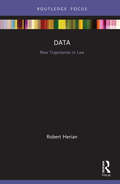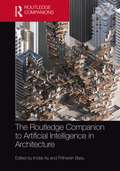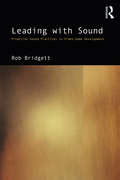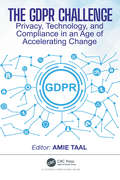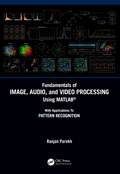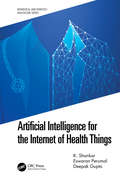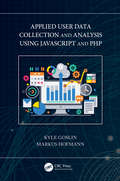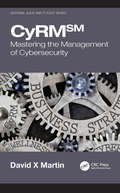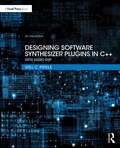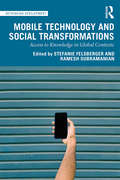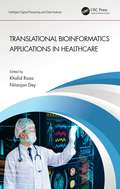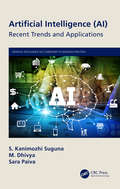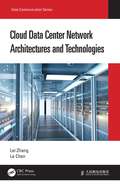- Table View
- List View
Data: New Trajectories in Law (New Trajectories in Law)
by Robert HerianThis book explores the phenomenon of data – big and small – in the contemporary digital, informatic and legal-bureaucratic context. Challenging the way in which legal interest in data has focused on rights and privacy concerns, this book examines the contestable, multivocal and multifaceted figure of the contemporary data subject. The book analyses "data" and "personal data" as contemporary phenomena, addressing the data realms, such as stores, institutions, systems and networks, out of which they emerge. It interrogates the role of law, regulation and governance in structuring both formal and informal definitions of the data subject, and disciplining data subjects through compliance with normative standards of conduct. Focusing on the ‘personal’ in and of data, the book pursues a re-evaluation of the nature, role and place of the data subject qua legal subject in on and offline societies: one that does not begin and end with the inviolability of individual rights but returns to more fundamental legal principles suited to considerations of personhood, such as stewardship, trust, property and contract. The book’s concern with the production, use, abuse and alienation of personal data within the context of contemporary communicative capitalism will appeal to scholars and students of law, science and technology studies, and sociology; as well as those with broader political interests in this area.
Data: New Trajectories in Law (New Trajectories in Law)
by Robert HerianThis book explores the phenomenon of data – big and small – in the contemporary digital, informatic and legal-bureaucratic context. Challenging the way in which legal interest in data has focused on rights and privacy concerns, this book examines the contestable, multivocal and multifaceted figure of the contemporary data subject. The book analyses "data" and "personal data" as contemporary phenomena, addressing the data realms, such as stores, institutions, systems and networks, out of which they emerge. It interrogates the role of law, regulation and governance in structuring both formal and informal definitions of the data subject, and disciplining data subjects through compliance with normative standards of conduct. Focusing on the ‘personal’ in and of data, the book pursues a re-evaluation of the nature, role and place of the data subject qua legal subject in on and offline societies: one that does not begin and end with the inviolability of individual rights but returns to more fundamental legal principles suited to considerations of personhood, such as stewardship, trust, property and contract. The book’s concern with the production, use, abuse and alienation of personal data within the context of contemporary communicative capitalism will appeal to scholars and students of law, science and technology studies, and sociology; as well as those with broader political interests in this area.
The Routledge Companion to Artificial Intelligence in Architecture
by Imdat As Prithwish BasuProviding the most comprehensive source available, this book surveys the state of the art in artificial intelligence (AI) as it relates to architecture. This book is organized in four parts: theoretical foundations, tools and techniques, AI in research, and AI in architectural practice. It provides a framework for the issues surrounding AI and offers a variety of perspectives. It contains 24 consistently illustrated contributions examining seminal work on AI from around the world, including the United States, Europe, and Asia. It articulates current theoretical and practical methods, offers critical views on tools and techniques, and suggests future directions for meaningful uses of AI technology. Architects and educators who are concerned with the advent of AI and its ramifications for the design industry will find this book an essential reference.
The Routledge Companion to Artificial Intelligence in Architecture
by Imdat As and Prithwish BasuProviding the most comprehensive source available, this book surveys the state of the art in artificial intelligence (AI) as it relates to architecture. This book is organized in four parts: theoretical foundations, tools and techniques, AI in research, and AI in architectural practice. It provides a framework for the issues surrounding AI and offers a variety of perspectives. It contains 24 consistently illustrated contributions examining seminal work on AI from around the world, including the United States, Europe, and Asia. It articulates current theoretical and practical methods, offers critical views on tools and techniques, and suggests future directions for meaningful uses of AI technology. Architects and educators who are concerned with the advent of AI and its ramifications for the design industry will find this book an essential reference.
Leading with Sound: Proactive Sound Practices in Video Game Development
by Rob BridgettLeading with Sound is the must-have companion guide to working on video game projects. Focused on the creative, collaborative, philosophical and organizational skills behind game sound and eschewing the technical, this book celebrates the subjects most essential to leading with sound in video game development at any level. Refuting the traditional optics of sound as a service in favour of sound as a pro-active visionary department, , this book examines each of the four food-groups of dialogue, sound design, music and mix, not through the usual technical and production lenses of ‘how’ and ‘when’, but the essential lens of ‘why’ that enables leadership with sound. Leading with Sound is essential reading for aspiring sound designers, inside and outside of the classroom, as well as experienced professionals in the game industry.
Leading with Sound: Proactive Sound Practices in Video Game Development
by Rob BridgettLeading with Sound is the must-have companion guide to working on video game projects. Focused on the creative, collaborative, philosophical and organizational skills behind game sound and eschewing the technical, this book celebrates the subjects most essential to leading with sound in video game development at any level. Refuting the traditional optics of sound as a service in favour of sound as a pro-active visionary department, , this book examines each of the four food-groups of dialogue, sound design, music and mix, not through the usual technical and production lenses of ‘how’ and ‘when’, but the essential lens of ‘why’ that enables leadership with sound. Leading with Sound is essential reading for aspiring sound designers, inside and outside of the classroom, as well as experienced professionals in the game industry.
The GDPR Challenge: Privacy, Technology, and Compliance in an Age of Accelerating Change
by Amie TaalConsent is necessary for collecting, processing and transferring Personal Identifiable Information (PII) and sensitive personal data. But to what extent? What are the limitations and restricts to avoid penalties under The General Data Protection Regulation 2018 (GDPR) rules, which may be up to 4% of annual global turnover or €20 million (whichever is higher), enforcements and sanctions? Under GDPR Article 51, each EU Member State shall maintain an independent public authority to be responsible for monitoring the application of this regulation to protect the fundamental rights of data subjects (Supervisory Authority). The Supervisory Authority has powers to issue warnings, conduct audits, recommend remediation, order erasure of data and suspend data transfers to a third country.GDPR has changed the way data is used, accessed and stored. It's reach extends well beyond the European Union and is the basis of other data privacy laws around the world.This book provides a review and guidance on implementing and compliance of GDPR while taking advantage of technology innovations and supported by real-life examples. The book shows the wide scope of applications to protect data privacy while taking advantage of processes and techniques in various fields such as eDiscovery, Cyber Insurance, Virtual-based Intelligence, Information Security, Cyber Security, Information Governance, Blockchain and Biometric technologies and techniques.
The GDPR Challenge: Privacy, Technology, and Compliance in an Age of Accelerating Change
by Amie TaalConsent is necessary for collecting, processing and transferring Personal Identifiable Information (PII) and sensitive personal data. But to what extent? What are the limitations and restricts to avoid penalties under The General Data Protection Regulation 2018 (GDPR) rules, which may be up to 4% of annual global turnover or €20 million (whichever is higher), enforcements and sanctions? Under GDPR Article 51, each EU Member State shall maintain an independent public authority to be responsible for monitoring the application of this regulation to protect the fundamental rights of data subjects (Supervisory Authority). The Supervisory Authority has powers to issue warnings, conduct audits, recommend remediation, order erasure of data and suspend data transfers to a third country.GDPR has changed the way data is used, accessed and stored. It's reach extends well beyond the European Union and is the basis of other data privacy laws around the world.This book provides a review and guidance on implementing and compliance of GDPR while taking advantage of technology innovations and supported by real-life examples. The book shows the wide scope of applications to protect data privacy while taking advantage of processes and techniques in various fields such as eDiscovery, Cyber Insurance, Virtual-based Intelligence, Information Security, Cyber Security, Information Governance, Blockchain and Biometric technologies and techniques.
Fundamentals of Image, Audio, and Video Processing Using MATLAB®: With Applications to Pattern Recognition
by Ranjan ParekhFundamentals of Image, Audio, and Video Processing Using MATLAB® introduces the concepts and principles of media processing and its applications in pattern recognition by adopting a hands-on approach using program implementations. The book covers the tools and techniques for reading, modifying, and writing image, audio, and video files using the data analysis and visualization tool MATLAB®. Key Features: Covers fundamental concepts of image, audio, and video processing Demonstrates the use of MATLAB® on solving problems on media processing Discusses important features of Image Processing Toolbox, Audio System Toolbox, and Computer Vision Toolbox MATLAB® codes are provided as answers to specific problems Illustrates the use of Simulink for audio and video processing Handles processing techniques in both the Spatio-Temporal domain and Frequency domain This is a perfect companion for graduate and post-graduate students studying courses on image processing, speech and language processing, signal processing, video object detection and tracking, and related multimedia technologies, with a focus on practical implementations using programming constructs and skill developments. It will also appeal to researchers in the field of pattern recognition, computer vision and content-based retrieval, and for students of MATLAB® courses dealing with media processing, statistical analysis, and data visualization. Dr. Ranjan Parekh, PhD (Engineering), is Professor at the School of Education Technology, Jadavpur University, Calcutta, India, and is involved with teaching subjects related to Graphics and Multimedia at the post-graduate level. His research interest includes multimedia information processing, pattern recognition, and computer vision.
Fundamentals of Image, Audio, and Video Processing Using MATLAB®: With Applications to Pattern Recognition
by Ranjan ParekhFundamentals of Image, Audio, and Video Processing Using MATLAB® introduces the concepts and principles of media processing and its applications in pattern recognition by adopting a hands-on approach using program implementations. The book covers the tools and techniques for reading, modifying, and writing image, audio, and video files using the data analysis and visualization tool MATLAB®. Key Features: Covers fundamental concepts of image, audio, and video processing Demonstrates the use of MATLAB® on solving problems on media processing Discusses important features of Image Processing Toolbox, Audio System Toolbox, and Computer Vision Toolbox MATLAB® codes are provided as answers to specific problems Illustrates the use of Simulink for audio and video processing Handles processing techniques in both the Spatio-Temporal domain and Frequency domain This is a perfect companion for graduate and post-graduate students studying courses on image processing, speech and language processing, signal processing, video object detection and tracking, and related multimedia technologies, with a focus on practical implementations using programming constructs and skill developments. It will also appeal to researchers in the field of pattern recognition, computer vision and content-based retrieval, and for students of MATLAB® courses dealing with media processing, statistical analysis, and data visualization. Dr. Ranjan Parekh, PhD (Engineering), is Professor at the School of Education Technology, Jadavpur University, Calcutta, India, and is involved with teaching subjects related to Graphics and Multimedia at the post-graduate level. His research interest includes multimedia information processing, pattern recognition, and computer vision.
Artificial Intelligence for the Internet of Health Things (Biomedical and Robotics Healthcare)
by K. Shankar Eswaran Perumal Deepak GuptaThis book discusses research in Artificial Intelligence for the Internet of Health Things. It investigates and explores the possible applications of machine learning, deep learning, soft computing, and evolutionary computing techniques in design, implementation, and optimization of challenging healthcare solutions. This book features a wide range of topics such as AI techniques, IoT, cloud, wearables, and secured data transmission. Written for a broad audience, this book will be useful for clinicians, health professionals, engineers, technology developers, IT consultants, researchers, and students interested in the AI-based healthcare applications. Provides a deeper understanding of key AI algorithms and their use and implementation within the wider healthcare sector Explores different disease diagnosis models using machine learning, deep learning, healthcare data analysis, including machine learning, and data mining and soft computing algorithms Discusses detailed IoT, wearables, and cloud-based disease diagnosis model for intelligent systems and healthcare Reviews different applications and challenges across the design, implementation, and management of intelligent systems and healthcare data networks Introduces a new applications and case studies across all areas of AI in healthcare data K. Shankar (Member, IEEE) is a Postdoctoral Fellow of the Department of Computer Applications, Alagappa University, Karaikudi, India. Eswaran Perumal is an Assistant Professor of the Department of Computer Applications, Alagappa University, Karaikudi, India. Dr. Deepak Gupta is an Assistant Professor of the Department Computer Science & Engineering, Maharaja Agrasen Institute of Technology (GGSIPU), Delhi, India.
Artificial Intelligence for the Internet of Health Things (Biomedical and Robotics Healthcare)
by K. Shankar Eswaran Perumal Deepak GuptaThis book discusses research in Artificial Intelligence for the Internet of Health Things. It investigates and explores the possible applications of machine learning, deep learning, soft computing, and evolutionary computing techniques in design, implementation, and optimization of challenging healthcare solutions. This book features a wide range of topics such as AI techniques, IoT, cloud, wearables, and secured data transmission. Written for a broad audience, this book will be useful for clinicians, health professionals, engineers, technology developers, IT consultants, researchers, and students interested in the AI-based healthcare applications. Provides a deeper understanding of key AI algorithms and their use and implementation within the wider healthcare sector Explores different disease diagnosis models using machine learning, deep learning, healthcare data analysis, including machine learning, and data mining and soft computing algorithms Discusses detailed IoT, wearables, and cloud-based disease diagnosis model for intelligent systems and healthcare Reviews different applications and challenges across the design, implementation, and management of intelligent systems and healthcare data networks Introduces a new applications and case studies across all areas of AI in healthcare data K. Shankar (Member, IEEE) is a Postdoctoral Fellow of the Department of Computer Applications, Alagappa University, Karaikudi, India. Eswaran Perumal is an Assistant Professor of the Department of Computer Applications, Alagappa University, Karaikudi, India. Dr. Deepak Gupta is an Assistant Professor of the Department Computer Science & Engineering, Maharaja Agrasen Institute of Technology (GGSIPU), Delhi, India.
Applied User Data Collection and Analysis Using JavaScript and PHP
by Kyle Goslin Markus HofmannApplied User Data Collection and Analysis Using JavaScript and PHP is designed to provide the technical skills and competency to gather a wide range of user data from web applications in both active and passive methods. This is done by providing the reader with real-world examples of how a variety of different JavaScript and PHP based libraries can be used to gather data using custom feedback forms and embedded data gathering tools. Once data has been gathered, this book explores the process of working with numerical data, text analysis, visualization approaches, statistics and rolling out developed applications to both data analysists and users alike.Using the collected data, this book aims to provide a deeper understanding of user behavior and interests allowing application developers to further enhance web application development. Key Features: Complete real-world examples of gathering data from users and web environments Offers readers the fundamentals of text analysis using JavaScript and PHP Allows the user to understand and harness JavaScript data visualization tools Integration of new and existing data sources into a single bespoke web-based analysis environment Author Bio: Dr. Kyle Goslin is currently a Lecturer in Computing at the Technological University Dublin in Ireland, specializing in web application development, information retrieval, text analysis and data visualization. Kyle has taught for over 10 years at third level in Ireland, teaching a wide range of web development related subjects. During this time, he has been involved in several different web-based data driven start-up companies with the aim of reducing time to market for businesses. Kyle has contributed to several different open-source learning platforms with the aim of making education accessible to all learners by aiding both teachers and students. Kyle has developed and defended a number of different third level computing courses validated by Quality and Qualifications Ireland. He has published peer-reviewed articles relating to information retrieval, text analysis and learning environments. In his spare time, he is a technical reviewer for data and software development related books. He holds a Bachelor of Science (Honours) and Doctor of Philosophy from the Technological University Dublin, where he currently lectures and lives. For more information, visit www.kylegoslin.ie Dr. Markus Hofmann is currently Senior Lecturer at the Technological University Dublin in Ireland where he focuses on the areas of data mining, text mining, data exploration and visualization as well as business intelligence. He holds a Ph.D. from Trinity College Dublin, an MSc in Computing (Information Technology for Strategic Management) from the Dublin Institute
Applied User Data Collection and Analysis Using JavaScript and PHP
by Kyle Goslin Markus HofmannApplied User Data Collection and Analysis Using JavaScript and PHP is designed to provide the technical skills and competency to gather a wide range of user data from web applications in both active and passive methods. This is done by providing the reader with real-world examples of how a variety of different JavaScript and PHP based libraries can be used to gather data using custom feedback forms and embedded data gathering tools. Once data has been gathered, this book explores the process of working with numerical data, text analysis, visualization approaches, statistics and rolling out developed applications to both data analysists and users alike.Using the collected data, this book aims to provide a deeper understanding of user behavior and interests allowing application developers to further enhance web application development. Key Features: Complete real-world examples of gathering data from users and web environments Offers readers the fundamentals of text analysis using JavaScript and PHP Allows the user to understand and harness JavaScript data visualization tools Integration of new and existing data sources into a single bespoke web-based analysis environment Author Bio: Dr. Kyle Goslin is currently a Lecturer in Computing at the Technological University Dublin in Ireland, specializing in web application development, information retrieval, text analysis and data visualization. Kyle has taught for over 10 years at third level in Ireland, teaching a wide range of web development related subjects. During this time, he has been involved in several different web-based data driven start-up companies with the aim of reducing time to market for businesses. Kyle has contributed to several different open-source learning platforms with the aim of making education accessible to all learners by aiding both teachers and students. Kyle has developed and defended a number of different third level computing courses validated by Quality and Qualifications Ireland. He has published peer-reviewed articles relating to information retrieval, text analysis and learning environments. In his spare time, he is a technical reviewer for data and software development related books. He holds a Bachelor of Science (Honours) and Doctor of Philosophy from the Technological University Dublin, where he currently lectures and lives. For more information, visit www.kylegoslin.ie Dr. Markus Hofmann is currently Senior Lecturer at the Technological University Dublin in Ireland where he focuses on the areas of data mining, text mining, data exploration and visualization as well as business intelligence. He holds a Ph.D. from Trinity College Dublin, an MSc in Computing (Information Technology for Strategic Management) from the Dublin Institute
CyRM℠: Mastering the Management of Cybersecurity (Internal Audit and IT Audit)
by David MartinIs your enterprise’s strategy for cybersecurity just crossing its fingers and hoping nothing bad ever happens? If so…you’re not alone. Getting cybersecurity right is all too often an afterthought for Fortune 500 firms, bolted on and hopefully creating a secure environment. We all know this approach doesn’t work, but what should a smart enterprise do to stay safe? Today, cybersecurity is no longer just a tech issue. In reality, it never was. It’s a management issue, a leadership issue, a strategy issue: It’s a "must have right"…a survival issue. Business leaders and IT managers alike need a new paradigm to work together and succeed. After years of distinguished work as a corporate executive, board member, author, consultant, and expert witness in the field of risk management and cybersecurity, David X Martin is THE pioneering thought leader in the new field of CyRMSM. Martin has created an entirely new paradigm that approaches security as a business problem and aligns it with business needs. He is the go-to guy on this vitally important issue. In this new book, Martin shares his experience and expertise to help you navigate today’s dangerous cybersecurity terrain, and take proactive steps to prepare your company—and yourself —to survive, thrive, and keep your data (and your reputation) secure.
CyRM℠: Mastering the Management of Cybersecurity (Internal Audit and IT Audit)
by David MartinIs your enterprise’s strategy for cybersecurity just crossing its fingers and hoping nothing bad ever happens? If so…you’re not alone. Getting cybersecurity right is all too often an afterthought for Fortune 500 firms, bolted on and hopefully creating a secure environment. We all know this approach doesn’t work, but what should a smart enterprise do to stay safe? Today, cybersecurity is no longer just a tech issue. In reality, it never was. It’s a management issue, a leadership issue, a strategy issue: It’s a "must have right"…a survival issue. Business leaders and IT managers alike need a new paradigm to work together and succeed. After years of distinguished work as a corporate executive, board member, author, consultant, and expert witness in the field of risk management and cybersecurity, David X Martin is THE pioneering thought leader in the new field of CyRMSM. Martin has created an entirely new paradigm that approaches security as a business problem and aligns it with business needs. He is the go-to guy on this vitally important issue. In this new book, Martin shares his experience and expertise to help you navigate today’s dangerous cybersecurity terrain, and take proactive steps to prepare your company—and yourself —to survive, thrive, and keep your data (and your reputation) secure.
Designing Software Synthesizer Plugins in C++: With Audio DSP
by Will C. PirkleDesigning Software Synthesizer Plugins in C++ provides everything you need to know to start designing and writing your own synthesizer plugins, including theory and practical examples for all of the major synthesizer building blocks, from LFOs and EGs to PCM samples and morphing wavetables, along with complete synthesizer example projects. The book and accompanying SynthLab projects include scores of C++ objects and functions that implement the synthesizer building blocks as well as six synthesizer projects, ranging from virtual analog and physical modelling to wavetable morphing and wave-sequencing that demonstrate their use. You can start using the book immediately with the SynthLab-DM product, which allows you to compile and load mini-modules that resemble modular synth components without needing to maintain the complete synth project code. The C++ objects all run in a stand-alone mode, so you can incorporate them into your current projects or whip up a quick experiment. All six synth projects are fully documented, from the tiny SynthClock to the SynthEngine objects, allowing you to get the most from the book while working at a level that you feel comfortable with. This book is intended for music technology and engineering students, along with DIY audio programmers and anyone wanting to understand how synthesizers may be implemented in C++.
Designing Software Synthesizer Plugins in C++: With Audio DSP
by Will C. PirkleDesigning Software Synthesizer Plugins in C++ provides everything you need to know to start designing and writing your own synthesizer plugins, including theory and practical examples for all of the major synthesizer building blocks, from LFOs and EGs to PCM samples and morphing wavetables, along with complete synthesizer example projects. The book and accompanying SynthLab projects include scores of C++ objects and functions that implement the synthesizer building blocks as well as six synthesizer projects, ranging from virtual analog and physical modelling to wavetable morphing and wave-sequencing that demonstrate their use. You can start using the book immediately with the SynthLab-DM product, which allows you to compile and load mini-modules that resemble modular synth components without needing to maintain the complete synth project code. The C++ objects all run in a stand-alone mode, so you can incorporate them into your current projects or whip up a quick experiment. All six synth projects are fully documented, from the tiny SynthClock to the SynthEngine objects, allowing you to get the most from the book while working at a level that you feel comfortable with. This book is intended for music technology and engineering students, along with DIY audio programmers and anyone wanting to understand how synthesizers may be implemented in C++.
Mobile Technology and Social Transformations: Access to Knowledge in Global Contexts (Rethinking Development)
by Stefanie Felsberger Ramesh SubramanianThis book investigates the ways in which the mobile telephone has transformed societies around the world, bringing both opportunities and challenges. At a time when knowledge and truth are increasingly contested, the book asks how mobile technology has changed the ways in which people create, disseminate, and access knowledge. Worldwide, mobile internet access has surpassed desktop access, and it is estimated that by 2022 there will be AN excess of 6 billion mobile phone users in the world. This widespread proliferation raises all sorts of questions around who creates knowledge, how is that knowledge shared and proliferated, and what are the structural political, economic, and legal conditions in which knowledge is accessed. The practices and power dynamics around mobile technologies are location specific. They look different depending on whether one chooses to highlight the legal, social, political, or economic context. Bringing together scholars, journalists, activists and practitioners from around the world, this book embraces this complexity, providing a multifaceted picture that acknowledges the tensions and contradictions surrounding accessing knowledge through mobile technologies. With case studies from Hong Kong, South Korea, India, Syria, Egypt, Botswana, Brazil, and the US, this book provides an important account of the changing nature of our access to knowledge, and is key reading for students, researchers, activists and policy makers with an interest in technology and access to knowledge, communication, social transformation, and global development.
Translational Bioinformatics Applications in Healthcare (Intelligent Signal Processing and Data Analysis)
by Khalid Raza Nilanjan DeyTranslational bioinformatics (TBI) involves development of storage, analytics, and advanced computational methods to harvest knowledge from voluminous biomedical and genomic data into 4P healthcare (proactive, predictive, preventive, and participatory). Translational Bioinformatics Applications in Healthcare offers a detailed overview on concepts of TBI, biological and clinical databases, clinical informatics, and pertinent real-case applications. It further illustrates recent advancements, tools, techniques, and applications of TBI in healthcare, including Internet of Things (IoT) potential, toxin databases, medical image analysis and telemedicine applications, analytics of COVID-19 CT images, viroinformatics and viral diseases, and COVID-19–related research. Covers recent technologies such as Blockchain, IoT, and Big data analytics in bioinformatics Presents the role of translational bioinformatic methods in the field of viroinformatics, as well as in drug development and repurposing Includes translational healthcare and NGS for clinical applications Illustrates translational medicine systems and their applications in better healthcare Explores medical image analysis with focus on CT images and novel coronavirus disease detection Aimed at researchers and graduate students in computational biology, data mining and knowledge discovery, algorithms and complexity, and interdisciplinary fields of studies, including bioinformatics, health-informatics, biostatistics, biomedical engineering, and viroinformatics. Khalid Raza is an Assistant Professor, the Department of Computer Science, Jamia Millia Islamia (Central University), New Delhi. His research interests include translational bioinformatics, computational intelligence methods and its applications in bioinformatics, viroinformatics, and health informatics. Nilanjan Dey is an Associate Professor, the Department of Computer Science and Engineering, JIS University, Kolkata, India. His research interests include medical imaging, machine learning, computer-aided diagnosis, and data mining.
Mobile Technology and Social Transformations: Access to Knowledge in Global Contexts (Rethinking Development)
by Stefanie FelsbergerThis book investigates the ways in which the mobile telephone has transformed societies around the world, bringing both opportunities and challenges. At a time when knowledge and truth are increasingly contested, the book asks how mobile technology has changed the ways in which people create, disseminate, and access knowledge. Worldwide, mobile internet access has surpassed desktop access, and it is estimated that by 2022 there will be AN excess of 6 billion mobile phone users in the world. This widespread proliferation raises all sorts of questions around who creates knowledge, how is that knowledge shared and proliferated, and what are the structural political, economic, and legal conditions in which knowledge is accessed. The practices and power dynamics around mobile technologies are location specific. They look different depending on whether one chooses to highlight the legal, social, political, or economic context. Bringing together scholars, journalists, activists and practitioners from around the world, this book embraces this complexity, providing a multifaceted picture that acknowledges the tensions and contradictions surrounding accessing knowledge through mobile technologies. With case studies from Hong Kong, South Korea, India, Syria, Egypt, Botswana, Brazil, and the US, this book provides an important account of the changing nature of our access to knowledge, and is key reading for students, researchers, activists and policy makers with an interest in technology and access to knowledge, communication, social transformation, and global development.
Translational Bioinformatics Applications in Healthcare (Intelligent Signal Processing and Data Analysis)
by Khalid Raza Nilanjan DeyTranslational bioinformatics (TBI) involves development of storage, analytics, and advanced computational methods to harvest knowledge from voluminous biomedical and genomic data into 4P healthcare (proactive, predictive, preventive, and participatory). Translational Bioinformatics Applications in Healthcare offers a detailed overview on concepts of TBI, biological and clinical databases, clinical informatics, and pertinent real-case applications. It further illustrates recent advancements, tools, techniques, and applications of TBI in healthcare, including Internet of Things (IoT) potential, toxin databases, medical image analysis and telemedicine applications, analytics of COVID-19 CT images, viroinformatics and viral diseases, and COVID-19–related research. Covers recent technologies such as Blockchain, IoT, and Big data analytics in bioinformatics Presents the role of translational bioinformatic methods in the field of viroinformatics, as well as in drug development and repurposing Includes translational healthcare and NGS for clinical applications Illustrates translational medicine systems and their applications in better healthcare Explores medical image analysis with focus on CT images and novel coronavirus disease detection Aimed at researchers and graduate students in computational biology, data mining and knowledge discovery, algorithms and complexity, and interdisciplinary fields of studies, including bioinformatics, health-informatics, biostatistics, biomedical engineering, and viroinformatics. Khalid Raza is an Assistant Professor, the Department of Computer Science, Jamia Millia Islamia (Central University), New Delhi. His research interests include translational bioinformatics, computational intelligence methods and its applications in bioinformatics, viroinformatics, and health informatics. Nilanjan Dey is an Associate Professor, the Department of Computer Science and Engineering, JIS University, Kolkata, India. His research interests include medical imaging, machine learning, computer-aided diagnosis, and data mining.
Artificial Intelligence: Recent Trends and Applications (Artificial Intelligence (AI): Elementary to Advanced Practices)
by S. Kanimozhi Suguna M. Dhivya Sara PaivaThis book aims to bring together leading academic scientists, researchers, and research scholars to exchange and share their experiences and research results on all aspects of Artificial Intelligence. The book provides a premier interdisciplinary platform to present practical challenges and adopted solutions. The book addresses the complete functional framework workflow in Artificial Intelligence technology. It explores the basic and high-level concepts and can serve as a manual for the industry for beginners and the more advanced. It covers intelligent and automated systems and its implications to the real-world, and offers data acquisition and case studies related to data-intensive technologies in AI-based applications. The book will be of interest to researchers, professionals, scientists, professors, students of computer science engineering, electronics and communications, as well as information technology.
Artificial Intelligence: Recent Trends and Applications (Artificial Intelligence (AI): Elementary to Advanced Practices)
by S. Kanimozhi Suguna, M. Dhivya, and Sara PaivaThis book aims to bring together leading academic scientists, researchers, and research scholars to exchange and share their experiences and research results on all aspects of Artificial Intelligence. The book provides a premier interdisciplinary platform to present practical challenges and adopted solutions. The book addresses the complete functional framework workflow in Artificial Intelligence technology. It explores the basic and high-level concepts and can serve as a manual for the industry for beginners and the more advanced. It covers intelligent and automated systems and its implications to the real-world, and offers data acquisition and case studies related to data-intensive technologies in AI-based applications. The book will be of interest to researchers, professionals, scientists, professors, students of computer science engineering, electronics and communications, as well as information technology.
Cloud Data Center Network Architectures and Technologies (Data Communication Series)
by Lei Zhang Le ChenCloud Data Center Network Architectures and Technologies has been written with the support of Huawei's vast technical knowledge and experience in the data center network (DCN) field, as well as its understanding of customer service requirements. This book describes in detail the architecture design, technical implementation, planning and design, and deployment suggestions for cloud DCNs based on the service challenges DCNs encounter. It starts by describing the overall architecture and technical evolution of DCNs, with the aim of helping readers understand the development of DCNs. It then proceeds to explain the design and implementation of cloud DCNs, including the service model of a single data center (DC), construction of physical and logical networks of DCs, construction of multiple DCNs, and security solutions of DCs. Next, this book dives deep into practices of cloud DCN deployment based on real-world cases to help readers better understand how to build cloud DCNs. Finally, this book introduces DCN openness and some of the hottest forward-looking technologies. In summary, you can use this book as a reference to help you to build secure, reliable, efficient, and open cloud DCNs. It is intended for technical professionals of enterprises, research institutes, information departments, and DCs, as well as teachers and students of computer network-related majors in colleges and universities. Authors Lei Zhang Mr. Zhang is the Chief Architect of Huawei's DCN solution. He has more than 20 years' experience in network product and solution design, as well as a wealth of expertise in product design and development, network planning and design, and network engineering project implementation. He has led the design and deployment of more than 10 large-scale DCNs for Fortune Global 500 companies worldwide. Le Chen Mr. Chen is a Huawei DCN Solution Documentation Engineer with eight years' experience in developing documents related to DCN products and solutions. He has participated in the design and delivery of multiple large-scale enterprise DCNs. Mr. Chen has written many popular technical document series, such as DCN Handbook and BGP Topic.
